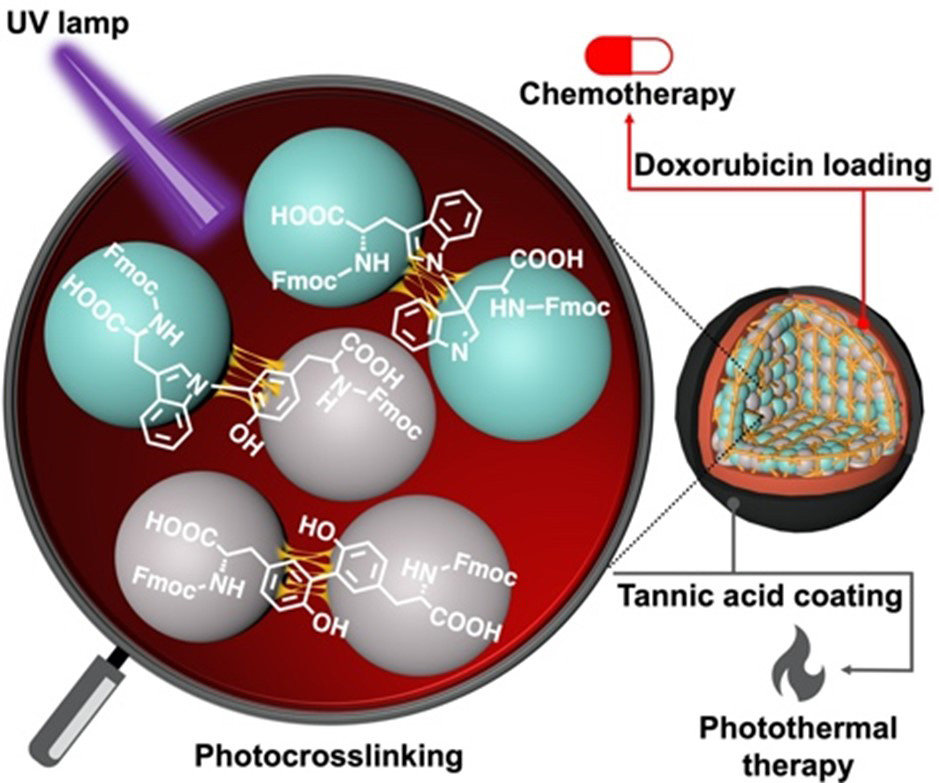Creating Novel Amino Acid Nanoparticles with Enhanced Anticancer Activity
Researchers use nanoparticles made of UV light crosslinked amino acids, loaded with doxorubicin and coated with tannic acid complex to target cancer cells
Amino acids are the fundamental building blocks of proteins and considered promising for biomedical applications. In a recent study now, researchers used ultraviolet light to self-assemble amino acids into crosslinked nanoparticles. These nanoparticles were loaded with doxorubicin and then coated with a tannic acid-iron complex, allowing for better drug release. Examination of anticancer activity of these nanoparticles in cancer cells and tumor-bearing mice revealed promising results, suggesting the potential of this approach for chemo-photothermal combined therapy.
Amino acids, such as tyrosine and tryptophan, are the fundamental building blocks that make up proteins. These biomolecules have different chemical groups on each end and side chain, and so, have the natural ability to form a chain through the formation of an amide (peptide) bond. However, such linkages are weak and easily degraded under physiological conditions. This is where the Fmoc-protected amino acids come into the picture.
In a new study now, a research team led by Dr. Eijiro Miyako, Associate Professor, Japan Advanced Institute of Science and Technology (JAIST) and Dr. Alberto Bianco and Dr. Cécilia Ménard-Moyon from the Centre National de la Recherche Scientifique (CNRS), France, employed ultraviolet light at 254 nm (leading to CBPUV nanoparticles) and riboflavin-mediated crosslinking at 365 nm (leading to CBPRibo nanoparticles) to crosslink the Fmoc-protected amino acids. "Amino acids being the building blocks of proteins have numerous advantages, such as better biocompatibility. Therefore, we wanted to create novel self-assembled amino acid-based nanoparticles which can be triggered through multiple mechanisms," says Dr. Eijiro Miyako, explaining the motivation behind their research. The findings of this study are published in Small.
The self-assembled amino acids were stably crosslinked dimers of Fmoc-Tyr-OH (Tyrosine) and Fmoc-Trp-OH (Tryptophan). Doxorubicin, an anticancer drug, was subsequently loaded into the crosslinked amino acid nanoparticles. To increase the stability of the nanoparticles, the researchers used a tannic acid-Iron (Fe3+) complex (or TAF) as the outer layer of coating. This coating can degrade inside the cells through the glutathione enzymatic release or by pH difference in the tumor microenvironment. The tannic acid coating can be also used in photothermal anticancer therapy, where external light can increase the local temperature surrounding the cancer tissue, causing cancer cell death.
The synthesized nanoparticles were then extensively studied for their structural integrity, stability, and drug release under different pH conditions. The functional profile, cellular uptake, and biocompatibility of self-assembled amino acid nanoparticles were then studied using cell culture techniques. Finally, the anticancer efficacy of synthesized nanoparticles was analyzed in tumor-bearing mice. The combined approach of chemotherapy, due to doxorubicin action, and photothermal therapy thanks to the tannic acid coating, showed excellent anticancer activity.
Post crosslinking, the amino acid-based nanoparticles showed notable changes in color, size, absorbance, fluorescence, and thermal stability. Furthermore, CBPUV exhibited superior stability after crosslinking, compared to CBPRibo. CBPUV also consistently maintained its structure, while CBPRibo showed partial disassembly, forming hollow spheres. Drug release study revealed minimal drug release under physiological pH (7.4), indicating that stable coating is crucial for in vivo delivery. At pH 5.5, incomplete coating degradation resulted in negligible drug release. However, the addition of glutathione (GSH) at pH 5.5 significantly boosted drug release by triggering TAF coating degradation, indicating GSH/pH responsiveness. The combined acidic and GSH treatment intensified coating degradation. This responsive behavior enables controlled drug release in specific physiological conditions. Furthermore, in vitro assessments revealed concentration-dependent cytotoxicity and improved efficacy in combined chemo/photothermal therapy. In vivo studies on tumor-bearing mice showcased significant tumor growth inhibition, indicating promising anticancer effects without observed side effects.
Sharing his concluding thoughts about the study findings, Dr. Miyako says, "Nanotechnology holds promise of transforming basic laboratory science into a powerful tool for combating complex diseases like cancer. We are optimistic that this pioneering research will advance, potentially evolving into cutting-edge cancer treatment technology ready for clinical trials within ten years."
Going ahead, the development of these self-assembled amino acid nanoparticles can help in fighting critical issues such as multi-drug resistance in cancer and improve the overall efficacy of treatment outcomes.

Image title: A representation of the amino acid-based nanoparticles loaded with doxorubicin and coated with tannic acid complex for a dual-action mechanism.
Image caption: Nanotechnology confers the ability to tailor the surface properties of nanoparticles and enhance the overall drug release profile. The use of tannic acid coating along with loading of the anticancer drug - doxorubicin, creates a smart drug delivery system that can be triggered to release the drug in a controlled and sustained manner, resulting in increased anticancer efficacy.
Image credit: Eijiro Miyako from JAIST.
License type: Original Content
Reference
| Title of original paper: | Photocrosslinked Co-assembled Amino Acid Nanoparticles for Controlled Chemo/photothermal Combined Anticancer Therapy |
| Authors: | Tengfei Wang, Yun Qi, Eijiro Miyako*, Alberto Bianco*, Cécilia Ménard-Moyon* |
| Journal: | Small |
| DOI: | 10.1002/smll.202307337 |
Funding information
This work was supported by the Centre National de la Recherche Scientifique (CNRS), by the Agence Nationale de la Recherche (ANR) through the LabEx project Chemistry of Complex Systems (ANR-10-LABX-0026_CSC) and by Jean-Marie Lehn Foundation. The author also thanks Japan Society for the Promotion of Science (JSPS) KAKENHI Grant-in-Aid for Scientific Research (A) (Grant number 23H00551), JSPS KAKENHI Grant-in-Aid for Challenging Research (Pioneering) (Grant number 22K18440), the Japan Science and Technology Agency for Adaptable and Seamless Technology Transfer Program through Target-driven R&D (Grant Number JPMJTR22U1), Institute for Fermentation, Osaka (IFO), and the Uehara Memorial Foundation.
January 9, 2024
